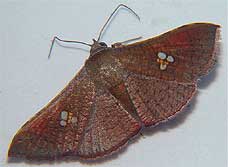THYRIDOIDS V. PYRALOIDS
 The Pyraloidea and the Thyridoidea have traditionally been treated together, with the Thyrididae included as a family in the Pyraloidea.
The Pyraloidea and the Thyridoidea have traditionally been treated together, with the Thyrididae included as a family in the Pyraloidea.
Recently, however, it has become increasingly clear that they are not closely related at all.. The Thyridoidea (thyridids or - more properly - 'thyridoids') are now seen as being a superfamily close to the butterflies (Papilionoidea, Hesperoidea, Hedyloidea), a more primitive group than the grouping of Pyraloidea as the sister group of the rest of the Macroheterocera.
It is worth noting in passing that to continue to formally regard both the Thyridoidea and Pyraloidea as 'micros' would be wrong unless one were to regard the butterflies as micros too! Indeed, recent molecular analyses by two separate teams of lepidopterists (Mutanen et al. 2010, Regier et al. 2013) have shown that the micros-macros division as applied before was artificial and that the two superfamilies are in separate groups. The Thyridoidea are grouped with the butterflies (Papilionoidea, Hesperoidea, Hedyloidea), a more primitive group than the grouping of Pyraloidea as the sister group of the Macroheterocera. Thus, it would probably be best to avoid the terms micros and macros altogether and be more precise in terms of what groups we are talking about. Referring to superfamily names is certainly a logical solution.'
Despite this recent determination that the Thyridoidea and the Pyraloidea are only distantly related, we have decided to address both superfamilies on this website since all but the most recent literature deals with the thyridids and the pyralids together. Thyridids are far less speciose and are scarcer both at light and in collections, which has made them easier to sort out for this Guide, so we are presenting them first.
In most cases they can be distinguished at a glance from pyralids because they exhibit a trademark reticulate (netted) patterning and often fenestrae (clear, hyaline windows) in the wings. They have been monographed in part by Whalley (1964, 1971a, 1971b, 1976).
Of the four subfamilies of the Thyrididae, one, the Zygaenid-like Charideinae, is restricted to Africa but the other three subfamilies, Siculodinae, Striglininae and Thyridinae are all represented in South-east Asia.
The Superfamily Thyridoidea is a recent construction to separate them out from the Pyraloidea based on the differences shown in Table 1 below. The key difference is the absence of abdominal tympanal organs.
The Pyraloidea are ditrysian* moths characterized by the following morphological features: paired tympanal chambers on sternite 2, each with a tympanum and a conjunctiva, maxillary palpus that is usually present, a basally scaled proboscis, veins R3 and R4 of the forewing stalked or fused, and Sc+R1 and Rs of the hind wing anastomosed distally to the discal cell (Solis, 2007).
*Ditrysian: so named because the female has two distinct sexual openings: one for mating, and the other for egg laying (in contrast to the Monotrysia). About 98% of all species of Lepidoptera belong to the Ditrysia.
As noted aboved, for many years the family Thyrididae was generally regarded as being associated with the Pyraloidea (Whalley 1976, Neunzig, 1987) but no synapomorphies have been identified that support that assignment (Scoble, 1995; Dugdale et al., 1999), and thyridids differ in a number of obvious ways. See Table 1. However the genus Addaea has a wing venation similar to the Pyralidae (Shaffer & Nielsen, 1996: 161). The structure of abdominal tympanal organs effectively characterises, as a monophyletic unit, the superfamily Pyraloidea. Also, within Pyraloidea, the primary division into Pyraliformes and Crambiformes (now Pyralidae and Crambidae) was established by tympanal organ morphology (Munroe, 1972: Minet, 1982; Maes, 1985).
Table 1. Differences between Pyralidae & Thyrididae after Whalley (1971a).
|
Morpological structure |
Pyraloidea |
Thyridoidea |
|
Palps |
Two pairs (maxillary & labial) usually present |
One pair (labial), maxillary being minute and hidden under scale cover |
|
Proboscis |
Scaled basally |
Naked |
|
Ocellae |
Frequent |
Usually absent |
|
Chaetosema |
Often present |
Absent |
|
Tympanal organ |
Ventral, in abdomen base |
Absent in abdomen |
|
Spinarea |
Present |
Generally absent but may be present in some Thyris spp. |
|
Hind wing |
3 anal veins; with Sc + R1 & Rs usually anastomosing posteriorly to the discal cell |
2 anal veins; with Sc + R1 & Rs usually arising from the wing base (free) (except the genus Addaea Walker, [1866] 1865 |
The thyridid moths are part of the large lepidopteran division of heteroneurous ditrysian moths (Ditrysia). Minet (notably, 1991) proposed three nested clades, the Apoditrysia, Obtectomera, and Macrolepidoptera. The Obtectomera are tentatively subdivided into two major divisions, one of which contains all the macrolepidopteran superfamilies (including the Rhopalocera), the other consists of a series of pyraloid grade superfamilies which consists of the Immoidea, Copromorphoidea, Pyraloidea, Thyridoidea and Mimallonoidea (Kristensen, 1998).
Current classification follows Minet (1983) in placing the family Thyrididae in a superfamily of its own, the Thyridoidea, although their larval projectile vomiting behaviour may link them to the Hyblaeoidea (Holloway et al., 2001).
The Simaethistidae is an obscure group of pyralid-like moths whose biology and relationships among the Ditrysia are currently unknown. It consists of two genera; Metaprotus (Hampson, 1899: 282) with two Australian species and Simaethistis from China and N. India with two further species (Dugdale et al. 1999). The two species of Whalleyana (Viette, 1977) are another enigmatic group of small moths, endemic to Madagascar. Minet (1991) put the Simaethistidae and the Whalleyanidae in the Thyridoidea but subsequently, as their taxonomic placement is still uncertain, Dugdale et al. (1999: 229-230) erected two new Obtectomera superfamilies: the Whalleyanoidea and the Simaethistoidea. Neither of these superfamilies occur in Borneo or nearby. Holloway et al., (2001) give a very useful key to all the Malesian lepidopteran families based on non-genitalic characteristics.

